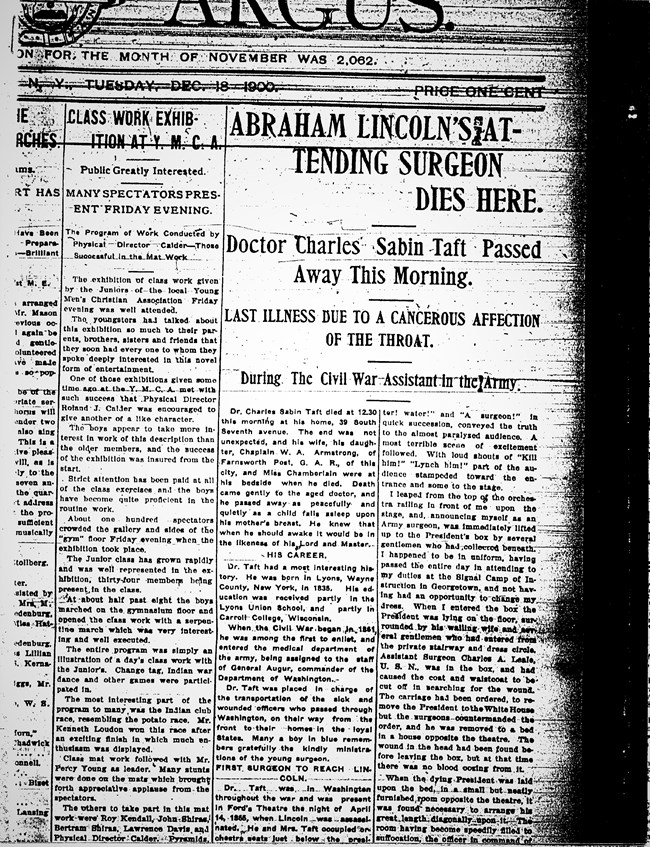Last updated: December 28, 2021
Article
Dr. Charles S. Taft: Lincoln assassination attending surgeon buried at St. Paul's

unknown
Dr. Charles S. Taft: Attending Surgeon at the Lincoln assassination buried at St. Paul's
Location, timing and coincidence are certainly pivotal elements in the intersection of people’s lives with great historical moments. The connection of Dr. Charles S. Taft with one of the most tragic events in our nation’s history -- the assassination of President Abraham Lincoln -- was clearly a matter of timing and location, but not really coincidence.
The 30-year-old army surgeon attended the performance of “Our American Cousin” at Ford’s Theatre in Washington on April 14, 1865, because he wanted to see the President. The Civil War had ended days earlier in Union victory, and Lincoln was a hero of monumental proportions. In the air of patriotism and celebration that swept the nation’s capital that week, people wanted to share the great moment with the commander-in-chief, and word spread around town that the President would be at the theatre that night.
“All went on pleasantly until half past ten o’clock, when, during the second scene of the third act, the sharp report of a pistol rang through the house,” Taft wrote the next day. “The report seemed to proceed from behind the scenes on the right of the stage, and behind the President’s box. While it startled everyone in the audience, it was evidently accepted by all as an introductory effect preceding some new situation in the play, several of which had been introduced in the earlier part of the performance. A moment afterward a hatless and white-faced man leaped from the front of the President’s box down, twelve feet, to the stage. As he jumped, one of the spurs on his riding boots caught in the folks of the flag draped over the front, and caused him to fall partly on his hands and knees as he struck the stage. Springing quickly to his feel with the suppleness of an athlete, he faced the audience for a moment as he brandished in his right hand a long knife, and shouted, “sic sempter tyrannis.” Then, with a rapid stage stride, he crossed the stage and disappeared from view.”
The man -- the assassin -- was John Wilkes Booth, extreme Southern sympathizer and off-duty actor who had just shot the President with a derringer pistol from point-blank range. “I leaped from the top of the orchestra railing in front of me upon the stage, and, announcing myself as an army surgeon, was immediately lifted up to the President’s box by several gentlemen who had collected beneath,” Taft recalled. He helped to diagnose the wound, declared to be mortal, and assisted in carrying Mr. Lincoln to a back room in a boardinghouse across the street.
Through the long night and vigil, in a small room filled with cabinet officers, Lincoln’s wife and son, and physicians, Dr. Taft assisted with various, almost hopeless medical procedures. In a famous painting of the deathbed scene, Dr. Taft is shown holding the President’s head.
Dr. Taft served as an Army surgeon at posts in the South through 1876, and held a private medical practice in New York City following his resignation from the army. Relocating to the more tranquil setting of Westchester County, Dr. Taft and his wife and daughter purchased a home on South 7th Avenue in Nt. Vernon, in May 1899; doctor’s row. This large wooden house still stands.. He attended the First Baptist Church in Mt. Vernon and was active in the local Farnsworth Post of the Grand Army of the Republic, the Civil War veterans’ organization.
But he was forever linked to that tragic episode on Good Friday at Ford’s Theatre. Months before his death, 35 years after the assassination, a young reporter for a New York City daily paper tracked down the aging Mt. Vernon doctor and urged him to recall -- once again-- the narrative of that evening. Dr. Taft died of throat cancer in his home at age 65 on December 18, 1900 surrounded by his family, and was interred the following day in the City cemetery section of the St. Paul’s graveyard.
